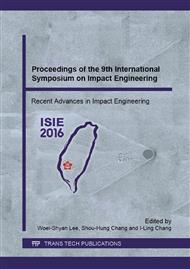p.122
p.128
p.133
p.139
p.147
p.153
p.159
p.167
p.174
Effect of Material Composition on Impact Energy Absorbing Capability of Composite Laminates
Abstract:
A novel experimental method was proposed for characterizing the energy absorbing capability of composite materials during the progressive crushing process under impact loading. A split Hopkinson pressure bars system was employed to carry out the progressive crushing tests under impact loading. The stress wave control technique was used to avoid the inhomogeneity of dynamic stress field in the specimen. The progressive crushing behavior was successfully achieved by using a coupon specimen and anti-buckling fixtures. With increasing strain rate, the absorbed energy during the crushing process slightly decreased, whereas the volume of the damaged part clearly increased regardless of material type. Consequently, the energy absorbing capability decreased with increasing loading rate. The effects of material composition, such as fiber type, matrix type and fabric pattern, on energy absorbing capability were also investigated by using the proposed method.
Info:
Periodical:
Pages:
147-152
Citation:
Online since:
September 2016
Authors:
Price:
Сopyright:
© 2016 Trans Tech Publications Ltd. All Rights Reserved
Share:
Citation:


